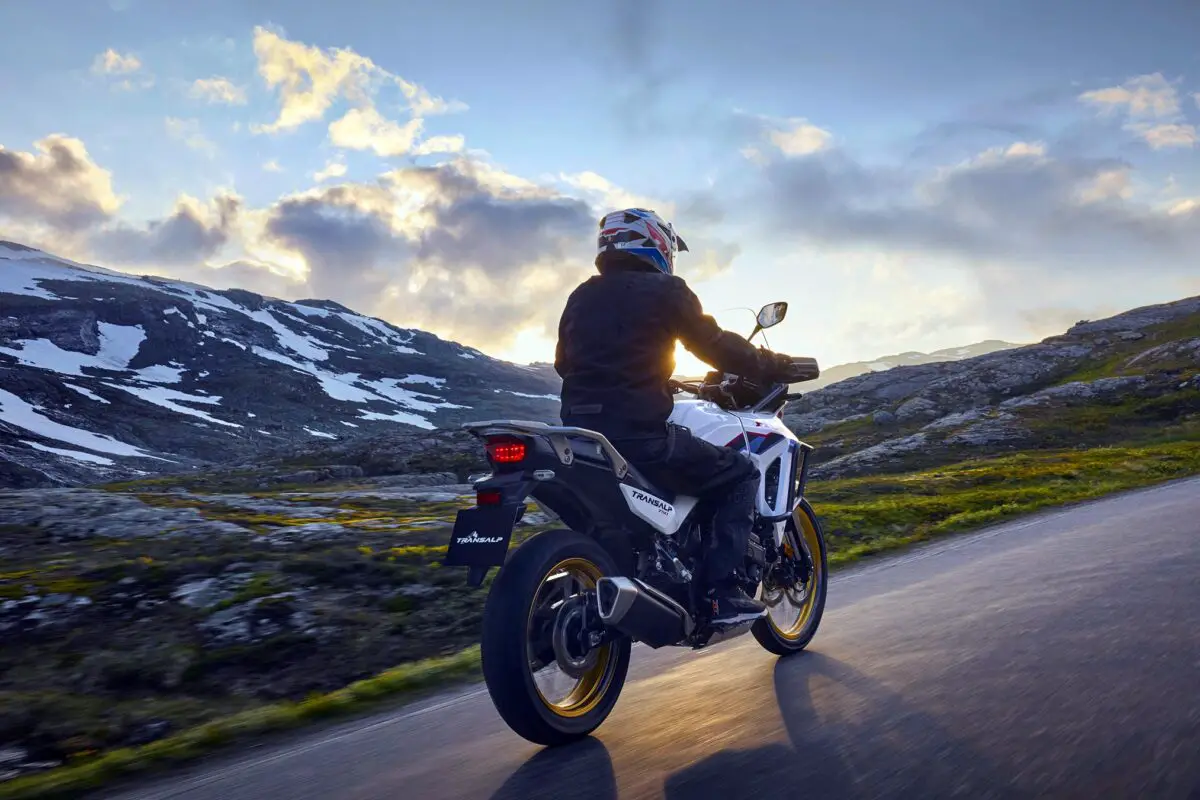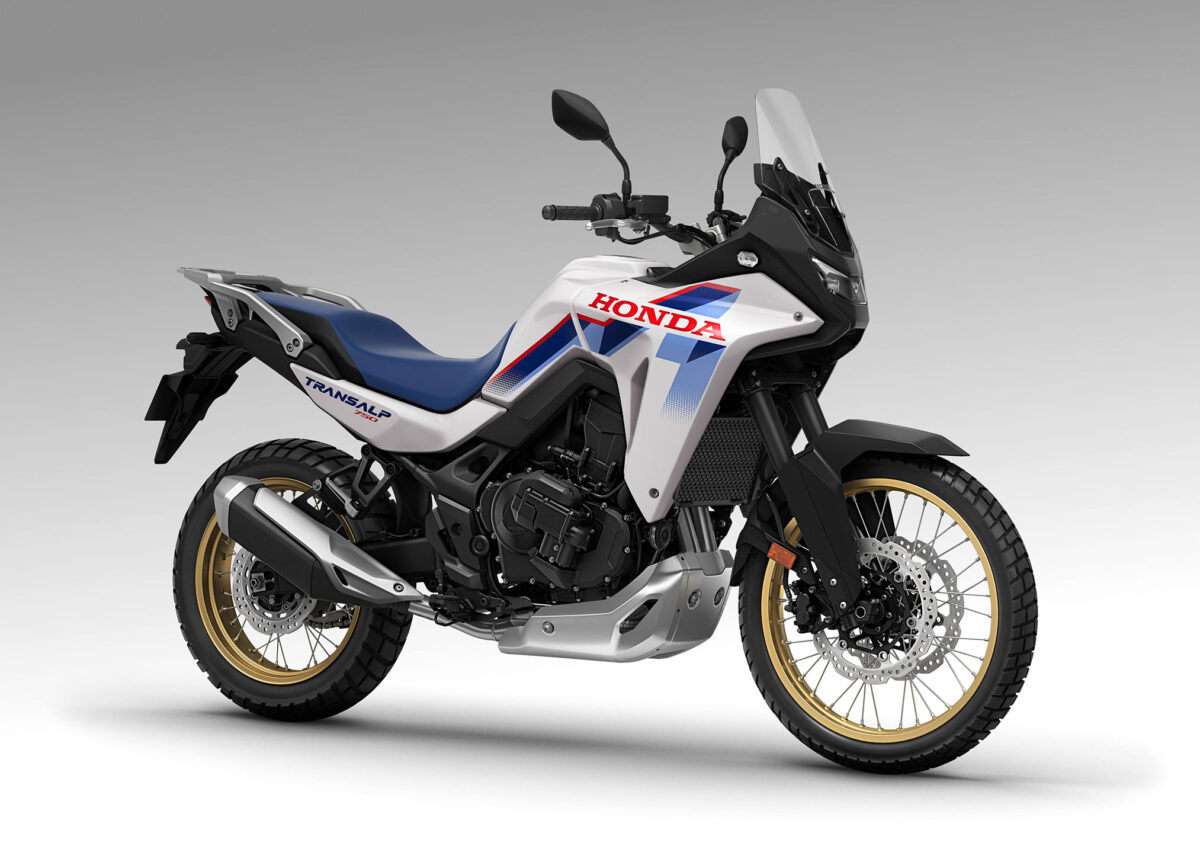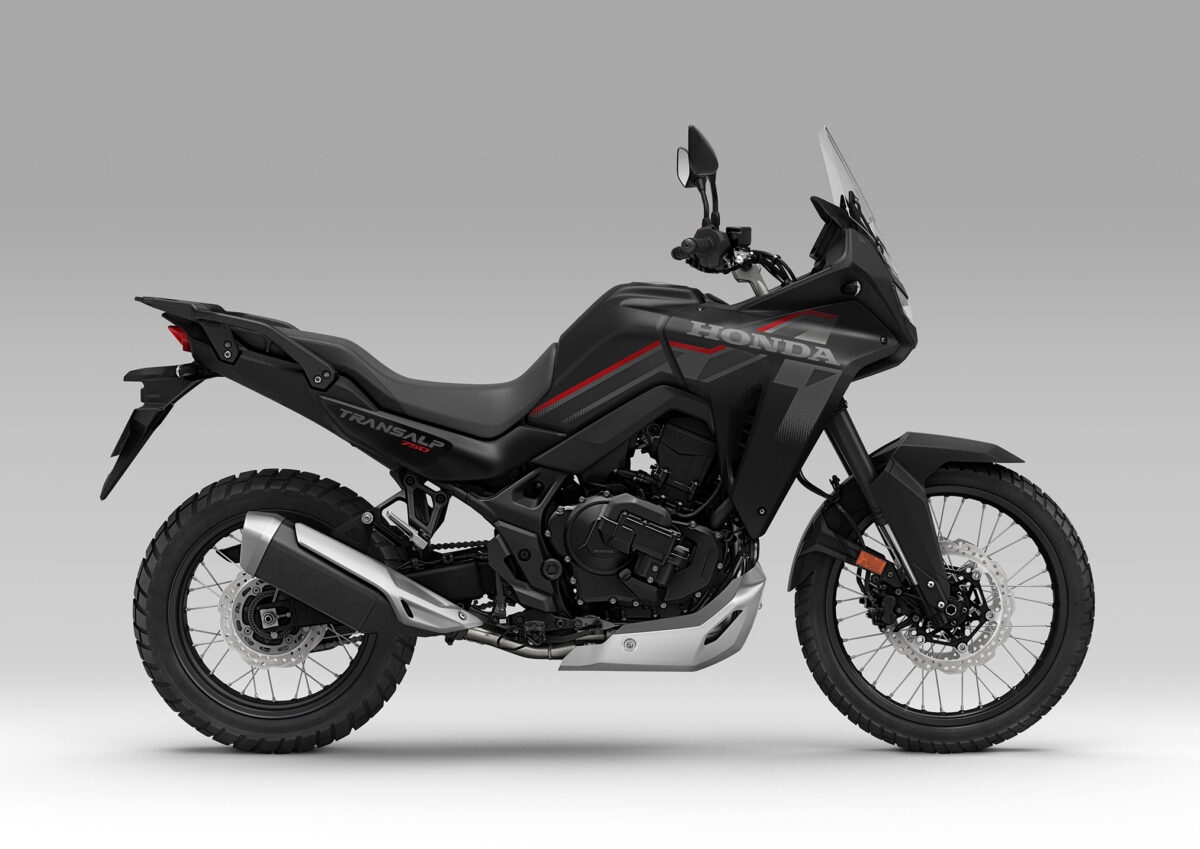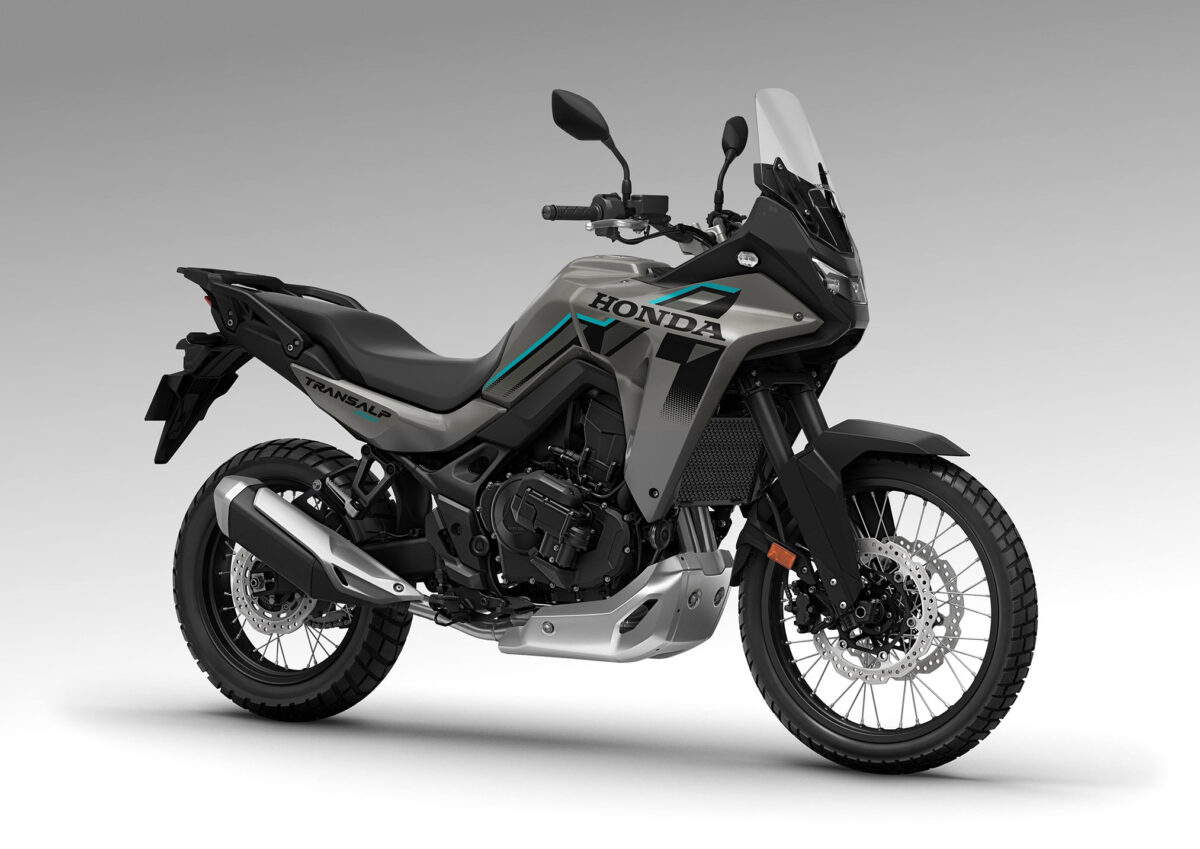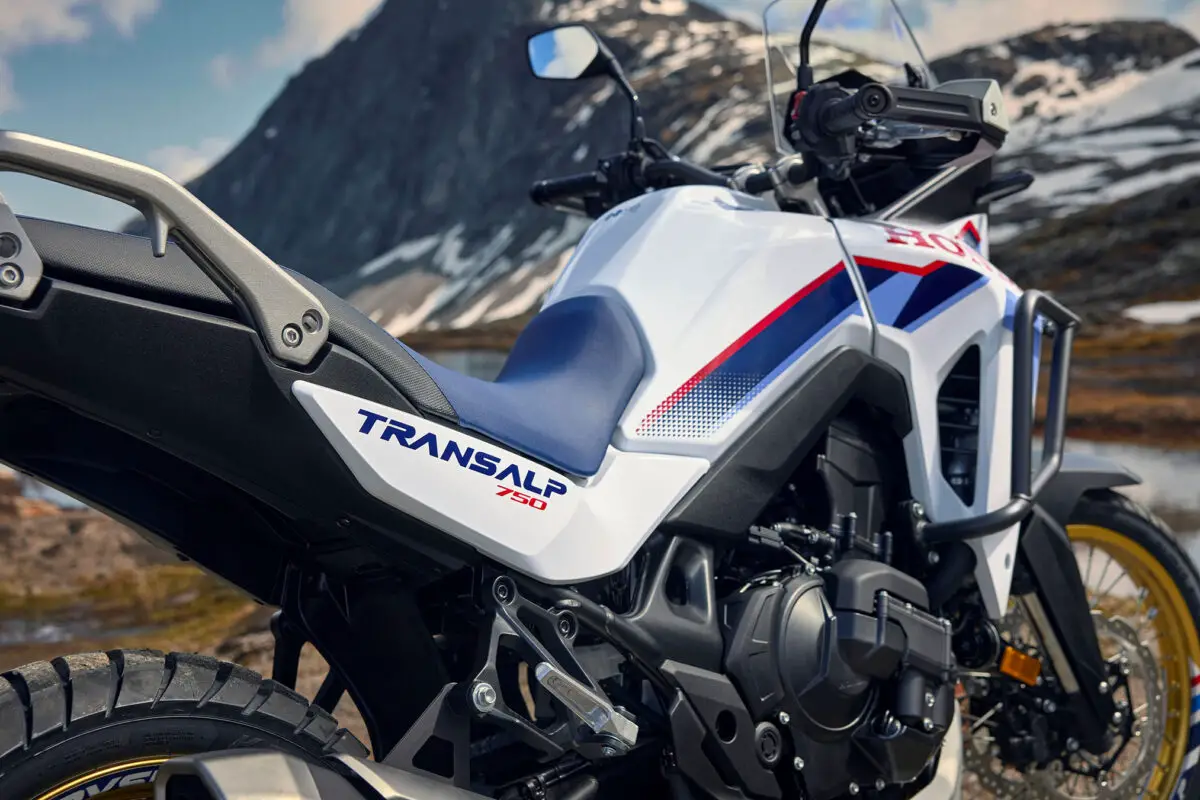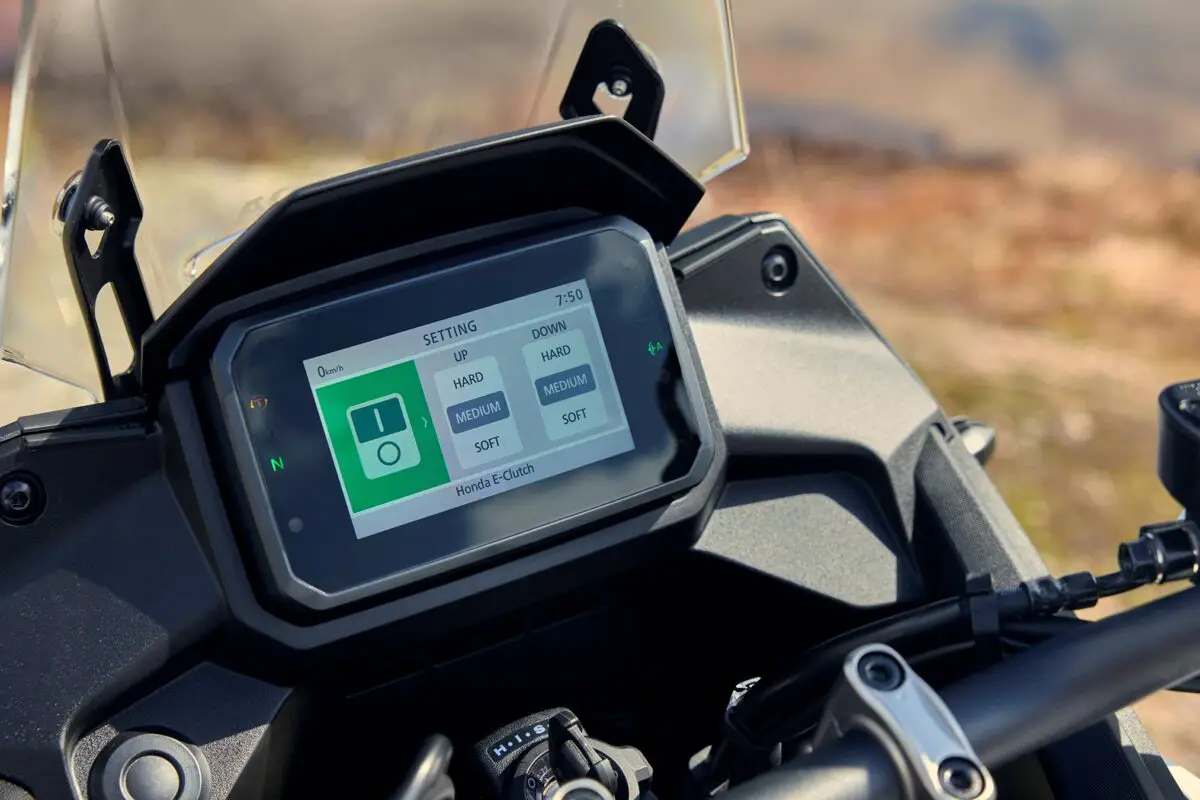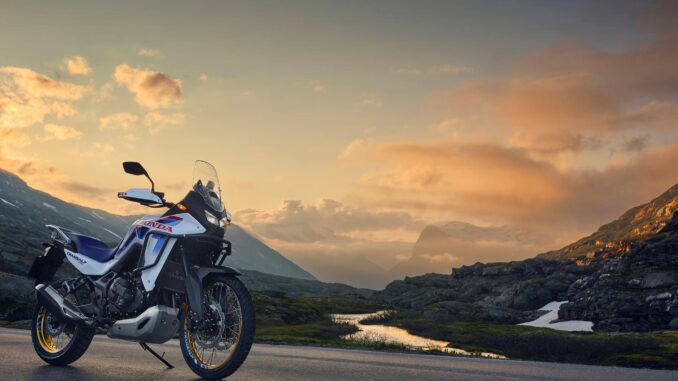
Honda’s adventure hero, the XL750 Transalp gains even more appeal for 2026 with the introduction of the option of Honda E-Clutch with TBW technology. The next generation of ‘clutchless’ riding unlocks more control, more versatility and more fun. On all surfaces.
Review – Key Features – Features & Benefits – Specifications
2026 Honda XL750 Transalp E-Clutch: START AND STOP WITH LESS EXPERIENCE.
Introducing the 2026 Honda XL750 Transalp E-Clutch…
The original Transalp, introduced in 1986 with a 583cc V-Twin engine is something of a legend. And, as testament to the sheer quality of its build and timelessness of its design, many can still be seen on Europe’s roads today. Back then, its focus was as a smooth, comfortable do-it-all crossover that could cope with rougher ground thanks to long-travel suspension and light off-road dynamic. By 2000 the engine had grown to 647cc and, for the last version in 2008 it landed with 680cc, fuel injection and a 214kg kerb weight.
The XL750 Transalp – which debuted in 2023 – was designed to fill a gap in the mid-capacity sector of Honda’s range as a model to attract customers with a different set of adventurous aspirations. Fittingly it took inspiration from the original and has proved perfect for an extended touring trip as well as the urban cut and thrust – and all points in-between.
It’s at home slicing through an Alpine pass or kicking up dust on rough tracks. And adds to the formula a high-performance engine and top-draw equipment level that modern riders demand. With updated suspension for 2025 (after an extensive European riding tour by both Japanese and European development engineers) and refreshed front fairing housing a powerful LED dual projector headlight, the Transalp offered an even stronger all-round package.
For 2026 Transalp gains further revisions to suspension settings, as well as a major advantage for on- and off-road use with the option of Honda E-Clutch, a technological evolution of the manual transmission that takes riding to the next level.
Just as it has from day one, the XL750 Transalp carries on as a truly brilliant all-rounder leaving only one question unanswered: How far do you want to go?
The XL750 Transalp’s design projects an unmistakeable feeling of adventure touring in a package that works superbly on the road. The tough, long-legged look is headed up by a dual LED projector headlight – drawing design influence from the Africa Twin – that adds to the adventurous styling and throws out powerful beams. Paired with this is an upper fairing that utilises a central duct to direct airflow around the helmet area, while the high-transparency DurabioTM screen is profiled to aid air flow around the rider’s body. Internal mid-cowl aerodynamics also work to enhance handling agility.
The engine packs a great deal of Honda’s engineering prowess into a small space and provides strong response across the rev-range – just what’s needed for either solo or two-up touring. The 755cc, parallel twin-cylinder unit (shared with the CB750 Hornet) produces 67.5kW peak power and a strong helping of torque right through the rev range, peaking at 75Nm. Settings of the Throttle By Wire (TBW) system orientate the engine character towards touring and comfort.
Compact, competition CRF-derived Unicam eight-valve cylinder heads employ downdraft air intakes and Vortex flow duct to ensure optimal combustion. The 270° crank delivers feel and character. Electronic rider aids run via Throttle By Wire (TBW) and include five riding modes, four of which contain pre-set combinations of Engine Power, Engine Braking, ABS and Honda Selectable Torque Control (HSTC) with integrated Wheelie Control. The 5th ‘User’ mode allows the rider to fix their own preferred combination.
And, for 2026, the option of Honda E-Clutch, working with the sophistication of TBW, provides some key advantages for the XL750 Transalp rider. Starting and stopping in the city is so much easier, and less tiring, by not having to use the clutch lever. More importantly, the system provides next level riding enjoyment, working much more quickly and smoothly than a quickshifter, up and down the gearbox. And off-road it is possible to change up smoothly, even when the rear wheel is spinning.
The Transalp’s handling is light, nimble and confidence inspiring. The steel diamond frame is light weight thanks to optimisation of wall/pipe thickness and stiffness. For supple on-road performance and off-road bump absorption, suspension is top quality: Showa 43mm SFF-CA USD forks and rear shock operating through Pro-Link. Set to deliver compliance on rougher terrain, while maintaining on-road composure both receive compression and rebound damping adjustment for 2026. Dual two-piston calipers provide efficient stopping power while the tyres – 90/90-21 and 150/70-18 front and rear respectively – deliver versatility on or off-road.
The rich specification list is headlined by a customisable, five-inch TFT colour display which relays information through a choice of three display types and management of all systems, as well as the connectivity of Honda RoadSync system for both Android and IOS devices. It’s operated, easily, by a 4-way toggle switch on the left handlebar. The indicators auto-cancel and include Emergency Stop Signal (ESS) technology to warn other road users of sudden braking.
Honda’s adventure hero, the XL750 Transalp gains even more appeal for 2026 with the introduction of the option of Honda E-Clutch with TBW technology. The next generation of ‘clutchless’ riding unlocks more control, more versatility and more fun. On all surfaces.
Around town or around the world Honda’s XL750 Transalp carries the adventure on from the iconic original, ready for a fresh generation of riders looking to travel wherever the road leads. And, for 2026, it receives a serious upgrade choice in the form of Honda E-Clutch with TBW technology, which offers tangible performance gains both on- and off-road. Honda E-Clutch versions also gain a stylish new aluminium skid-plate for added protection and a boost of stylish ruggedness. As before the eight-valve, parallel twin-cylinder engine delivers 67.5kW and 75Nm; Throttle By Wire (TBW) also serves up four default riding modes plus two User options. and is tied in with the five-level Honda Selectable Torque Control (HSTC) with integrated Wheelie Control and the three levels of Engine Braking and Power. The steel frame wears full Showa suspension: 43mm SFF-CATM USD forks and rear shock working through Pro-Link and for 2026 both front and rear suspension are equipped with compression and rebound damping adjustment. Dual, two-piston brake calipers bite hard up front and 21/18-inch wheels wear tubed tyres. The Transalp’s premium specification includes dual LED projector headlights, a five-inch TFT screen with Honda RoadSync smartphone connectivity and four-way toggle switch, auto-indicator cancel and Emergency Stop Signals (ESS) technology. An A2 licence option is also available.
2026 Honda XL750 Transalp E-Clutch Totalmotorcycle.com Key Features
The 2026 XL750 Transalp will be available in the following colour options:
- Ross White Tricolour
- Mat Ballistic Black Metallic
- Pearl Deep Mud Gray
For the new model year, all three colours feature a revised contemporary graphics package.
- Fairing and bodywork balance wind protection, on-road comfort and off-road ability
- Central aero duct, DurabioTM screen and internal mid-cowl airflow management enhance aerodynamics and agility
- Compact, powerful dual projector headlight
- Practicality from 850mm seat height, USB socket and rear carrier
- Five-inch TFT display with four-way handlebar toggle switch and Honda RoadSync Android/IOS smartphone connectivity
- Emergency Stop Signal (ESS) technology for the rear indicators
- 755cc, 8-valve Unicam parallel twin-cylinder engine with 270° crank
- 67.5kW @ 9,500rpm, 75Nm torque @ 7,250rpm and 35kW A2 licence option
- Transalp-specific TBW mapping for touring focus
- Patented Vortex flow intake ducts and tuned exhaust note
- Assist/slipper clutch
- Lightweight 18.3kg steel diamond frame with integrated subframe
- Showa 43mm SFF-CA USD forks/Pro-link rear shock, both spring preload adjustable and now with compression/rebound damping adjustment
- Two-piston front calipers and 310mm wave discs; single piston caliper/256mm rear disc
- 21/18-inch wheels wear 90/90-21 and 150/70-18 front and rear tyres
2026 Honda XL750 Transalp E-Clutch Totalmotorcycle.com Features and Benefits
Styling & Equipment
The XL750 Transalp’s design is functional, minimalistic, durable, and incorporates styling elements from the flagship Africa Twin. Leading the tough look, the dual LED headlight utilises high/low unified projector lenses. New for 2026 is a revised, sharper and more compact skid plate for a more seamless integration with the Transalp’s silhouette. Standard on the Honda E-Clutch variant, the new unit follows customer feedback and has been redesigned and reengineered from 2.5mm thick high-strength aluminium offering protection to the engine from stones and other abrasions.
Manufactured from high transparency (and sustainable) DurabioTM the screen mounts on the upper fairing, which employs a central intake duct to control back pressure reducing buffeting around the helmet. The middle cowl section features internals optimised to suppress flow velocity, for nimbler handling in urban situations and on twisting roads. A Genuine Honda Accessories Tall Screen is available, alongside Upper ‘A’ Deflectors that reduce wind disturbance.
This bike is built to go the distance, so genuine comfort – also for two – matters. Seat height is low for the class at 850mm (an 820mm low seat is also available as an option) and the riding position is upright for natural control and leverage. The riding geometry also works well when standing up. A rear carrier is standard and there’s a USB socket under the seat.
The five-inch full colour TFT screen uses optical bonding to improve visibility in bright sunlight. By sealing the gap between the cover glass and TFT screen with resin, glare is reduced, and backlight transmittance improved. Riders can customise the read out to their preferences, with three styles (bar, circle, and simple) as well as a high-contrast black background available to choose from. The IOS/Android smartphone connectivity of Honda RoadSync is built in.
This feature – alongside a simplified, easy-to-use, backlit four-way toggle-switch on the left handlebar – allows straightforward, on-screen turn-by-turn navigation as well as the option (via a Bluetooth helmet headset) for the rider to make calls or listen to music. All an owner need do is download the Honda RoadSync app from either the Play Store or the App Store, connect to the XL750 Transalp, and go.
To simplify and miniaturise the entire electrical system the Transalp uses a Controller Area Network (CAN) alongside a Body Control Unit (BCU). The BCU is sited on the left-hand frame rail, under the fuel tank and collectively processes control signals – from the ABS modulator, TFT screen and switch gear.
The rear indicators feature an Emergency Stop Signal (ESS) function. At a minimum speed of 56km/h with either brake working, if negative acceleration of a minimum of 6.0m/s2 is detected, the hazard lights flash to warn other road users a hard stop is in process. At the same speed the threshold is reduced if ABS is activated, to a negative acceleration of a minimum 2.5m/s2.
Front and rear indicators also auto-cancel; rather than using a simple timer, the system compares front and rear wheel speed difference and calculates when to cancel the indication relative to the situation.
Engine
The 755c, 8-valve Unicam engine is unchanged for 2026. Bore and stroke is set at 87 x 63.5mm, with compression ratio of 11.0:1. It produces a hard hit of top end power, with maximum output of 67.5kW @ 9,500rpm. This is accompanied by mountains of usable torque in the low to mid rpm range, rising to a peak of 75Nm @ 7,250rpm. The result is an engine that provides usable, enjoyable performance for rides of all types and all distances, and for riders of all experience levels.
It’s extremely compact and lightweight, due in no small part to the Unicam head (as used by the MX competition ready CRF450R) which operates the 35.5mm diameter inlet valves (with 9.3mm lift) via cam, and 29mm diameter exhaust (with 8.2mm lift) by rocker arm. The compact dimensions are also due to clever packaging: there’s no balancer drive gear since the primary drive gear doubles up duties and spins the balance shaft; the water pump is tucked away inside the lefthand engine cover and there’s no need for a water-cooled oil-cooler.
For razor-sharp pick-up and throttle response, patented Vortex flow ducts create a more uniform distribution from the side scoops into the airbox, which then feeds downdraft intakes and 46mm diameter throttle bodies. The cylinders use a Ni-SiC (Nickel-Silicon Carbide) coating, as used on the CRF450R and CBR1000RR-R Fireblade, to increase the engine’s efficiency.
The crank uses a 270° firing order for characterful, twin-cylinder pulse feeling. The exhaust note is tuned for a pleasing low-end beat and raucous top-end howl. While mechanically identical to the CB750 Hornet, the Transalp’s TBW settings are tuned differently to focus on an engine ‘flavour’ in keeping with the long distance, touring work for which the Transalp is made. An assist/slipper clutch – with oblique layout disc segments – offers light lever feel, eases up shifts and manages rear wheel hop under hard braking and rapid down changes.
The catalyser has been upgraded and an SO2 added for forward looking legislative compliance. Fuel consumption of 23.km/l (WMTC mode) offers a potential range of 390km from the 16.9L fuel tank. A 35kW A2 licence option will be available from a Honda dealer.
Engine Electronics
Throttle By Wire (TBW) engine control offers four default riding modes: SPORT, STANDARD, RAIN and GRAVEL, adjusting the engine’s performance delivery and feel to suit conditions and the rider’s intent; they’re easily switched and managed between the left handlebar mode and TFT screen. There is also a specific USER mode that allows the rider to fine tune their own personal settings
There are four levels of Engine Power (EP), three levels of Engine Brake (EB), two levels of ABS, and five levels of Honda Selectable Torque Control (HSTC) available; HSTC and rear ABS can also be switched off. The riding modes offer different combinations of each parameter. Wheelie Control is also standard and integrated to HSTC.
- SPORT mode offers maximum performance and uses level four EP, level two ABS and level one EB and HSTC to deliver strong acceleration with minimum intervention.
- STANDARD mode is a mid-way setting for urban riding that uses level three setting for EP and HSTC, with level two EB and ABS.
- RAIN mode is designed for challenging on-road conditions and employs the lowest EP setting, level one, for the least aggressive power delivery with level two EB and ABS and five HSTC.
- GRAVEL mode features level two EP, level three EB, and level four HSTC with level one ABS setting for confident travel on rougher terrain off road.
- USER1/ USER2 mode allows the rider to choose between settings one through four EP, one through five HSTC and one through three EB plus rear ABS switch off. All settings, except ABS settings, are retained when the ignition is switched off.
Chassis
The steel diamond mainframe is lightweight, at just 18.3kg – 10% lighter than the frame of the CB500X. A major R&D process of reducing the number of reinforcing parts, thinning of the main and down tubes, and optimisation of the upper shock mount and swingarm pivot shape has produced a hugely strong platform, with rigidity balanced to deliver feel to the rider across all conditions and geometry set to inspire confident handling agility. The integrated heavy-duty subframe employs high-tension steel pipework for strength and toughness.
Rake and trail are set at 27° and 111mm, with wheelbase of 1560mm and kerb weight of 210kg. Slow speed U-turns are easy thanks to a 42° steering angle and 2.6m minimum turning circle. Ground clearance is 210mm.
The suspension settings are designed to maintain on-road comfort with excellent bump absorption over rougher ground. Showa 43mm SFF-CATM (Separate Function Fork-Cartridge) USD forks offer 200mm travel with spring preload adjustment, and mount by a forged aluminium bottom yoke and cast aluminium top yoke. With 190mm travel the remote reservoir Showa shock (with adjustable preload) operates through Pro-Link and the swingarm which, while employing the same castings as the CRF1100L Africa Twin’s, uses aluminium material exclusive to the Transalp.
For 2026 both the front forks and rear shock feature compression/rebound damping adjustment, widening the performance potential, both in terms of rider preference and conditions.
Compact, two-piston calipers work dual 310mm ‘wave’ discs. The rear 256mm ‘wave’ disc is operated by a single-piston caliper. 21/18-inch front rear (stainless steel) spoked wheels wear (tubed) 90/90-21 and 150/70-18 tyres; Metzeler Karoo Street or Dunlop Mixtour.
–
- Honda E-Clutch
- Advanced Honda technology that brings ‘next level’ sporty riding performance
- Also allows the rider to start, stop and change gear without using the clutch lever – just the gear shift pedal
- First version with Throttle-by-Wire makes its debut on the 750cc pairing of Hornet and Transalp introducing even more rider benefits
- Combination with TBW control offers extremely smooth downshifting with auto blip function for an even sportier ride
- Throttle butterfly opening also linked to riding mode selection
- Available as an option from new
- Honda E-Clutch also allows normal operation of the clutch lever
The Honda E-Clutch system – which debuted on the 2024 CB650R and CBR650R – brings ‘next level’ riding enjoyment and performance, allowing consistent gear changes that are faster and smoother than a quickshifter.
As well as performance, it offers simplicity of operation. The clutch lever is not needed when pulling away or coming to a stop and there’s no need to use the lever to make a shift either up or down the gearbox. The rider simply operates the shift pedal to change gear.
A half clutch position smooths the up/down shift, and the engine’s ignition timing and fuel injection are also controlled, based on parameters such as vehicle speed, throttle opening angle, engine rpm, pressure on the shift pedal, clutch motor reduction gear angle, engine countershaft speed and gear position. The clutch operation itself is performed through an actuator unit with two motors situated inside the right-hand engine cover.
And, with the XL750 Transalp’s Throttle By Wire (TBW) control, Honda E-Clutch offers an even greater advantage, especially on downshifts. When the half-clutch position is activated TBW blips the throttle, matching engine revs to rear wheel speed for even smoother shifting.
Honda E-Clutch also adjusts the throttle butterfly opening range depending on riding mode selection. For instance, RAIN mode is suitable for extreme weather conditions, SPORT heightens the experience, for maximum enjoyment and riding pleasure. The system also detects rear wheel ‘hop’ under rapid downshifting and braking and employs half-clutch to stabilise the situation. Off-road, another performance boost is smooth upshifts while the rear wheel is spinning; Honda E-Clutch monitors front/rear wheel speed and shifts with appropriate control.
The rider can also select an ‘operation feel’ to set the strength of the force required on the shift pedal to make a gear change. Three settings are available: HARD, MEDIUM, and SOFT, each of which can be chosen independently for upshifting and downshifting. The system will also advise the rider to shift down – via a symbol on the instrument panel – if it detects the motorcycle is in a high gear at a certain speed.
And the system is the ultimate in versatility, as the clutch lever can be used as normal at any time. After use, the Honda E-Clutch system will re-activate after less than a second above a certain engine rpm, and after 5 seconds at lower engine speeds. Should the rider wish to turn off the system for a particular ride, this is also possible via the switchgear on the left handlebar, once the vehicle is stationary and in neutral. The change to manual operation is indicated by a letter ‘M’ on the instrument panel.
For extra legroom, the mounting structure of the Honda E-Clutch has been adjusted by dividing the clutch lifter shaft in two and adding a gear train, offsetting it 40mm away from the foot. Also, the anti-vibration rubber and stays of the standard clutch cover design were found to be unnecessary in testing, following optimization of the engine cover design, ultimately saving 300g.
Accessories
A full range of Genuine Honda Accessories are available for the XL750 Transalp either individually or as part of five curated packs for convenience. Changes for the 2026 include a new black coloured version for the following accessories: Engine Guards, Front Side Pipes, Top Box Base and Top Bag Attachment, updated Side Panniers (26L right/33L left) and 50L Top Box with decorative Stickers, and a new design for the Tank Side Sticker.
Urban Pack
Enhances your XL750’s practicality with features that improve convenience, making it ideal for both everyday commutes or longer journeys: 50L Top Box with Stickers, Aluminium Panel, Mounting Base, Pillion Backrest, Inner Bag plus Tall Screen and Main Stand.
Touring Pack
Designed to enhance long-distance comfort and functionality, making the bike ideal for extended road trips and touring adventures. Includes the convenience of Comfort Pillion Steps, Panniers with Stickers (26L right/33L left), dedicated Support Stays, Inner Bags and the12V Socket allowing the charge of electronic devices.
Adventure Pack
Focused on increasing durability, visibility, and readiness for all kinds of terrain from Side Pipes, LED Fog Lights and Radiator Grill.
Rally Pack
Enhances the motorcycle’s ability to handle rugged, off-road environments with speed and precision while keeping the rider comfortable in competitive or adventurous rally conditions. The performance upgrade of a Quick Shifter (for non E-Clutch variant), plus Engine Guard in Black and Bash Plate protection, Knuckle Guards with extensions and the Wheel Stripes – available in Black and White – add the final touch.
Comfort Pack
This pack focuses on reducing fatigue and providing a smoother, more comfortable and enjoyable experience. The Fairing and Windscreen Deflectors expand wind and weather protection. Comfort is enhanced through the addition of an extra-padded Seat and Heated Grips. The handy Tank Bag is a convenient addition for travel.
Additional accessories include Tank Side Pipe and Soft Side Bags, with the option to mount the Left one as a Top Bag trough the specific attachment. All accessories are available separately.
2026 Honda XL750 Transalp E-Clutch – Totalmotorcycle.com USA Specifications/Technical Details
US MSRP Price: $ TBA USD
Canada MSRP Price: $ TBA CDN (includes Freight, PDI and Fees)
Europe/UK MSRP Price: £ See Dealer for Pricing in GBP (On The Road inc 20% Vat)
TBA
2026 Honda XL750 Transalp E-Clutch – Totalmotorcycle.com Canada Specifications/Technical Details
TBA
2026 Honda XL750 Transalp E-Clutch – Totalmotorcycle.com Europe Specifications/Technical Details
| XL750 Transalp | XL750 Transalp (A2 Version) | XL750 Transalp E-Clutch | XL750 Transalp E-Clutch (A2 Version) | |
| ENGINE | ||||
| Engine Type | Liquid-cooled SOHC 4-stroke 8-valve Parallel Twin with 270° crank | |||
| Engine Displacement | 755 cc | |||
| Bore x Stroke (mm) | 87 mm x 63.5 mm | |||
| Compression Ratio | 11.0:1 | |||
| Max. Power Output | 67.5 kW at 9,500 rpm | 34.5 kW at 5,250 rpm | 67.5 kW at 9,500 rpm | 34.5 kW at 5,250 rpm |
| Max. Torque | 75 Nm at 7.250 rpm | 66 Nm at 4,750 rpm | 75 Nm at 7.250 rpm | 66 Nm at 4,750 rpm |
| Stationary sound Level (dB) | 95 dB | 88 dB | 95 dB | 88 dB |
| Max Speed | 195 km/h | 160 km/h | 195 km/h | 160 km/h |
| Oil Capacity | 3.9 L | |||
| Starter | E-Starter | |||
| FUEL SYSTEM | ||||
| Carburation | PGM-FI Fuel Injection | |||
| Fuel Tank Capacity | 16.9 L | |||
| CO2 Emissions WMTC | 102 g/km | 97 g/km | 102 g/km | 97 g/km |
| Fuel Consumption | 4.3 L/100km | 4.2 L/100km | 4.3 L/100km | 4.2 L/100km |
| ELECTRICAL SYSTEM | ||||
| Battery Type | AGM | |||
| Battery Capacity | 12 V 9.1Ah (20HR) | |||
| DRIVETRAIN | ||||
| Clutch Type | Wet multiple, Assisted slipper clutch | |||
| Transmission Type | 6-speed Manual Transmission | |||
| Final Drive | Chain | |||
| FRAME | ||||
| Frame Type | Diamond Steel Frame | |||
| CHASSIS | ||||
| Dimensions (L´W´H) | 2,325 mm x 838 mm x 1,455 mm | |||
| Wheelbase | 1,560 mm | |||
| Caster Angle | 27° | |||
| Trail | 111 mm | |||
| Seat Height | 850 mm | |||
| Ground Clearance | 210 mm | |||
| Kerb Weight | 210 kg | 216 kg | ||
| Turning radius | 2.6m | |||
| SUSPENSION | ||||
| Suspension Front | Showa 43 mm SFF-CA USD, 200 mm travel | |||
| Suspension Rear | Monoshock damper, Prolink swingarm, 190 mm travel | |||
| WHEELS | ||||
| Wheels Front | 21 x 2.15 Stainless spoke, Aluminium rim, Tube type | |||
| Wheels Rear | 18 M/C x MT4.00 Stainless spoke, Aluminium rim, Tube type | |||
| Tyres Front | 90/90-21M/C 54H | |||
| Tyres Rear | 150/70R18M/C 70H | |||
| BRAKES | ||||
| ABS Type | 2-channel ABS (Rear ABS can be deactiviated) | |||
| Brakes Front | Axial mounted two-piston brake caliper, 310 mm floating double disc | |||
| Brakes Rear | Single piston caliper, 256 mm single disc | |||
| INSTRUMENTS & ELECTRICS | ||||
| Instruments | 5-inch TFT Panel Multi information display | |||
| Headlight | LED | |||
| Taillight | LED | |||
| Connectivity | RoadSync | |||
| USB | Type – C | |||
| Auto Winker Cancel | Yes | |||
| Security System | HISS | |||
| Riding mode | Sport, Standard, Rain, Gravel and USER1/ USER2 Mode | |||
| HSTC | 3 Level + OFF | |||
| Additional Features | ESS | |||
All specifications are provisional and subject to change without notice.
# Please note that the figures provided are results obtained by Honda under standardised testing conditions prescribed by WMTC. Tests are conducted on a rolling road using a standard version of the vehicle with only one rider and no additional optional equipment. Actual fuel consumption may vary depending on how you ride, how you maintain your vehicle, weather, road conditions, tire pressure, installation of accessories, cargo, rider and passenger weight, and other factors.
Manufacturer Specifications and appearance are subject to change without prior notice on Total Motorcycle (TMW).



